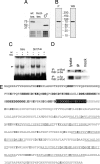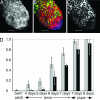Transcriptional regulation by Modulo integrates meiosis and spermatid differentiation in male germ line
- PMID: 16877538
- PMCID: PMC1567683
- DOI: 10.1073/pnas.0605087103
Transcriptional regulation by Modulo integrates meiosis and spermatid differentiation in male germ line
Abstract
Transcriptional activation in early spermatocytes involves hundreds of genes, many of which are required for meiosis and spermatid differentiation. A number of the meiotic-arrest genes have been identified as general regulators of transcription; however, the gene-specific transcription factors have remained elusive. To identify such factors, we purified the protein that specifically binds to the promoter of spermatid-differentiation gene Sdic and identified it as Modulo, the Drosophila homologue of nucleolin. Analysis of gene-expression patterns in the male sterile modulo mutant indicates that Modulo supports high expression of the meiotic-arrest genes and is essential for transcription of spermatid-differentiation genes. Expression of Modulo itself is under the control of meiotic-arrest genes and requires the DAZ/DAZL homologue Boule that is involved in the control of G(2)/M transition. Thus, regulatory interactions among Modulo, Boule, and the meiotic-arrest genes integrate meiosis and spermatid differentiation in the male germ line.
Conflict of interest statement
Conflict of interest statement: No conflicts declared.
Figures




Similar articles
-
The CPEB protein Orb2 has multiple functions during spermatogenesis in Drosophila melanogaster.PLoS Genet. 2012;8(11):e1003079. doi: 10.1371/journal.pgen.1003079. Epub 2012 Nov 29. PLoS Genet. 2012. PMID: 23209437 Free PMC article.
-
Transcriptional and post-transcriptional control mechanisms coordinate the onset of spermatid differentiation with meiosis I in Drosophila.Development. 1998 Jan;125(1):125-34. doi: 10.1242/dev.125.1.125. Development. 1998. PMID: 9389670
-
A novel requirement in mammalian spermatid differentiation for the DAZ-family protein Boule.Hum Mol Genet. 2010 Jun 15;19(12):2360-9. doi: 10.1093/hmg/ddq109. Epub 2010 Mar 24. Hum Mol Genet. 2010. PMID: 20335278 Free PMC article.
-
DAZ Family Proteins, Key Players for Germ Cell Development.Int J Biol Sci. 2015 Aug 15;11(10):1226-35. doi: 10.7150/ijbs.11536. eCollection 2015. Int J Biol Sci. 2015. PMID: 26327816 Free PMC article. Review.
-
Putative biological functions of the DAZ family.Int J Androl. 2004 Jun;27(3):125-9. doi: 10.1111/j.1365-2605.2004.00469.x. Int J Androl. 2004. PMID: 15139965 Review.
Cited by
-
Tombola, a tesmin/TSO1-family protein, regulates transcriptional activation in the Drosophila male germline and physically interacts with always early.Development. 2007 Apr;134(8):1549-59. doi: 10.1242/dev.000521. Epub 2007 Mar 14. Development. 2007. PMID: 17360778 Free PMC article.
-
The RNA-binding protein Modulo promotes neural stem cell maintenance in Drosophila.PLoS One. 2024 Dec 19;19(12):e0309221. doi: 10.1371/journal.pone.0309221. eCollection 2024. PLoS One. 2024. PMID: 39700092 Free PMC article.
-
Distinctive pattern of expression of spermatogenic molecular markers in testes of azoospermic men with non-mosaic Klinefelter syndrome.J Assist Reprod Genet. 2016 Jun;33(6):807-14. doi: 10.1007/s10815-016-0698-0. Epub 2016 Mar 19. J Assist Reprod Genet. 2016. PMID: 26995389 Free PMC article.
-
Relocation facilitates the acquisition of short cis-regulatory regions that drive the expression of retrogenes during spermatogenesis in Drosophila.Mol Biol Evol. 2014 Aug;31(8):2170-80. doi: 10.1093/molbev/msu168. Epub 2014 May 22. Mol Biol Evol. 2014. PMID: 24855141 Free PMC article.
-
Derepression of Y-linked multicopy protamine-like genes interferes with sperm nuclear compaction in D. melanogaster.Proc Natl Acad Sci U S A. 2023 Apr 18;120(16):e2220576120. doi: 10.1073/pnas.2220576120. Epub 2023 Apr 10. Proc Natl Acad Sci U S A. 2023. PMID: 37036962 Free PMC article.
References
-
- Fuller M. T. Semin. Cell. Dev. Biol. 1998;9:433–444. - PubMed
-
- White-Cooper H., Schafer M. A., Alphey L. S., Fuller M. T. Development (Cambridge, U.K.) 1998;125:125–134. - PubMed
-
- White-Cooper H., Leroy D., MacQueen A., Fuller M. T. Development (Cambridge, U.K.) 2000;127:5463–5473. - PubMed
-
- Wang Z., Mann R. S. Development (Cambridge, U.K.) 2003;130:2853–2865. - PubMed
-
- Ayyar S., Jiang J., Collu A., White-Cooper H., White R. A. Development (Cambridge, U.K.) 2003;130:2841–2852. - PubMed
Publication types
MeSH terms
Substances
Grants and funding
LinkOut - more resources
Full Text Sources
Molecular Biology Databases

